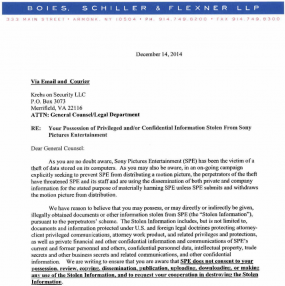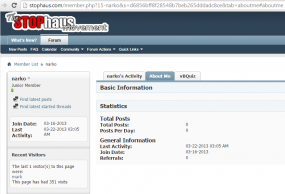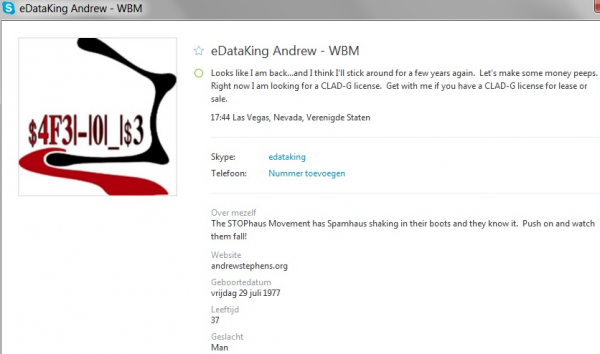FBI: North Korea to Blame for Sony Hack
vendredi 19 décembre 2014 à 19:50The FBI today said it has determined that the North Korean government is responsible for the devastating recent hack attack against Sony Pictures Entertainment. Here’s a brief look the FBI’s statement, what experts are learning about North Korea’s cyberattack capabilities, and what this incident means for other corporations going forward.
In a statement released early Friday afternoon, the FBI said that its investigation — along with information shared by Sony and other U.S. government departments and agencies — found that the North Korean government was responsible.
The FBI said it couldn’t disclose all of its sources and methods, but that the conclusion was based, in part, on the following:
-“Technical analysis of the data deletion malware used in this attack revealed links to other malware that the FBI knows North Korean actors previously developed. For example, there were similarities in specific lines of code, encryption algorithms, data deletion methods, and compromised networks.”
-“The FBI also observed significant overlap between the infrastructure used in this attack and other malicious cyber activity the U.S. government has previously linked directly to North Korea. For example, the FBI discovered that several Internet protocol (IP) addresses associated with known North Korean infrastructure communicated with IP addresses that were hardcoded into the data deletion malware used in this attack.”
-“Separately, the tools used in the SPE attack have similarities to a cyber attack in March of last year against South Korean banks and media outlets, which was carried out by North Korea.”
The agency added that it was “deeply concerned” about the destructive nature of this attack on a private sector entity and the ordinary citizens who work there, and that the FBI stands ready to assist any U.S. company that is the victim of a destructive cyber attack or breach of confidential information.
“Further, North Korea’s attack on SPE reaffirms that cyber threats pose one of the gravest national security dangers to the United States,” the FBI said. “Though the FBI has seen a wide variety and increasing number of cyber intrusions, the destructive nature of this attack, coupled with its coercive nature, sets it apart. North Korea’s actions were intended to inflict significant harm on a U.S. business and suppress the right of American citizens to express themselves. Such acts of intimidation fall outside the bounds of acceptable state behavior. The FBI takes seriously any attempt—whether through cyber-enabled means, threats of violence, or otherwise—to undermine the economic and social prosperity of our citizens.”
SPE was hit with a strain of malware designed to wipe all computer hard drives within the company’s network. The attackers then began releasing huge troves of sensitive SPE internal documents, and, more recently, started threatening physical violence against anyone who viewed the Sony movie “The Interview,” a comedy that involves a plot to assassinate North Korean leader Kim Jong Un. Not long after a number of top movie theater chains said they would not show the film, Sony announced that it would cancel the movie’s theatrical release.
Apparently emboldened by Sony’s capitulation, the attackers are now making even more demands. According to CNN, Sony executives on Thursday received an email apparently from the attackers said they would no longer release additional stolen Sony Pictures data if the company announced that it would also cancel any plans to release the movie on DVD, Netflix or elsewhere. The attackers also reportedly demanded that any teasers and trailers about The Interview online be removed from the Internet.
A ‘MAGIC WEAPON’
Little is publicly known about North Korea’s cyber warfare and hacking capabilities, but experts say North Korean leaders view cyber warfare capabilities as an important asymmetric asset in the face of its perceived enemies — the United States and South Korea. An in-depth report (PDF) released earlier this year by HP Security Research notes that in November 2013, North Korea’s “dear leader” Kim Jong Un referred to cyber warfare capabilities as a “magic weapon” in conjunction with nuclear weapons and missiles.
“Although North Korea’s limited online presence makes a thorough analysis of their cyber warfare capabilities a difficult task, it must be noted that what is known of those capabilities closely mirrors their kinetic warfare tactics,” HP notes. “Cyber warfare is simply the modern chapter in North Korea’s long history of asymmetrical warfare. North Korea has used various unconventional tactics in the past, such as guerilla warfare, strategic use of terrain, and psychological operations. The regime also aspires to create viable nuclear weapons.”
Sources familiar with the investigation tell KrebsOnSecurity that the investigators believe there may have been as many as several dozen individuals involved in the attack, the bulk of whom hail from North Korea. Nearly a dozen of them are believed to reside in Japan.
According to HP, a group of ethnic North Koreans residing in Japan known as the Chongryon are critical to North Korea’s cyber and intelligence programs, and help generate hard currency for the regime. The report quotes Japanese intelligence officials stating that “the Chongryon are vital to North Korea’s military budget, raising funds via weapons trafficking, drug trafficking, and other black market activities.” HP today published much more detail about specific North Korean hacking groups that may have played a key role in the Sony incident given previous such attacks.
While the United States government seems convinced by technical analysis and intelligence sources that the North Koreans were behind the attack, skeptics could be forgiven for having doubts about this conclusion. It is interesting to note that the attackers initially made no mention of The Interview, and instead demanded payment from Sony to forestall the release of sensitive corporate data. It wasn’t until well after the news media pounced on the idea that the attack was in apparent retribution for The Interview that we saw the attackers begin to mention the Sony movie.
In any case, it’s unlikely that U.S. officials relish the conclusion that North Korea is the aggressor in this attack, because it forces the government to respond in some way and few of the options are particularly palatable. The top story on the front page of the The Wall Street Journal today is an examination of what the U.S. response to this incident might look like, and it seems that few of the options on the table are appealing to policymakers and intelligence agencies alike.
The WSJ story notes that North Korea’s only connections to the Internet run through China, but that pressuring China to sever or severely restrict those connections is unlikely to work.
Likewise, engaging in a counter-attack could prove fruitless, or even backfire, the Journal observed, “in part because the U.S. is able to spy on North Korea by maintaining a foothold on some of its computer systems. A retaliatory cyberstrike could wind up damaging Washington’s ability to spy on Pyongyang…Another former U.S. official said policy makers remain squeamish about deploying cyberweapons against foreign targets.”
IMPLICATIONS FOR US FIRMS
If this incident isn’t a giant wake-up call for U.S. corporations to get serious about cybersecurity, I don’t know what is. I’ve done more than two dozen speaking engagements around the world this year, and one point I always try to drive home is that far too few organizations recognize how much they have riding on their technology and IT operations until it is too late. The message is that if the security breaks down, the technology stops working — and if that happens the business can quickly grind to a halt. But you would be hard-pressed to witness signs that most organizations have heard and internalized that message, based on their investments in cybersecurity relative to their overall reliance on it.
A critical step that many organizations fail to take is keeping a basic but comprehensive and ongoing inventory of all the organization’s IT assets. Identifying where the most sensitive and mission-critical data resides (identifying the organization’s “crown jewels”) is another essential exercise, but too many organizations fail to take the critical step of encrypting this vital information.
Over the past several years, we’ve seen a remarkable shift toward more destructive attacks. Most organizations are accustomed to tackling malware infestations within their IT environments, but few are prepared to handle fast-moving threats designed to completely wipe data from storage drives across the network.
As I note in my book Spam Nation, miscreants who were once content to steal banking information and blast out unsolicited commercial email increasingly are using their skills to hold data for ransom using malware tools such as ransomware. I’m afraid that as these attackers become better at situational awareness — that is, gaining a better understanding of who their victims are and the value of the assets the intruders have under their control — these attacks and ransom demands will become more aggressive and costly in the months ahead.








